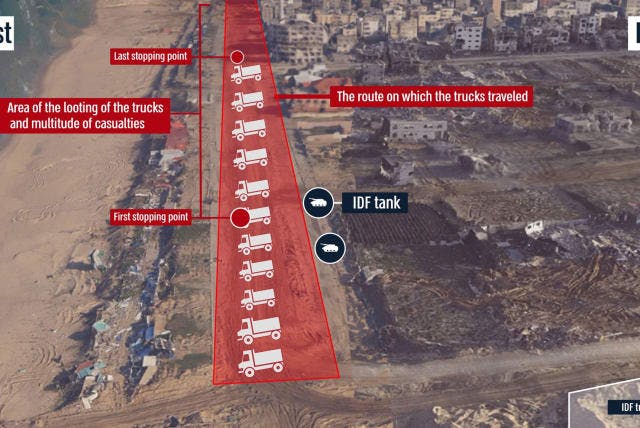Vast Difficulties of Delivering Aid to Gaza in Focus as Biden Stresses Its Importance
An initial Israel Defense Force investigation into a February 29 stampede that killed dozens of Gazans concludes Israeli troops did not shoot at a truck convoy delivering aid to the northern Strip.

Just as the Gaza war is one of the most complex military operations in history, so is the delivery of aid to non-combatants, a task that President Biden is increasingly highlighting as central to his Mideast strategy. Yet could global efforts to help Gazans end up backfiring, or even prove deadly?
On Friday, an initial Israel Defense Force investigation into a February 29 stampede that killed dozens of Gazans concluded Israeli troops did not shoot at a truck convoy delivering aid to the northern Strip. Although the incident was widely blamed on Israel at the time, it showed that the most complicated issue is aid distribution inside Gaza, rather than how the goods get there.
Nevertheless, Americans, Europeans, and some Arab countries are looking for various ways to get humanitarian aid to Gaza. Much food, medicine, and other forms of aid is expected to arrive Saturday on a ship from Cyprus. In his State of the Union speech Thursday, Mr. Biden promised to erect a “temporary pier” to receive such deliveries off Gaza’s shores.
“What if some Gazan decides to shoot an RPG at that pier?” one diplomat at the United Nations asked the Sun. “Wouldn’t that drag America into the war?”
Americans, Jordanians, and others have for weeks conducted airdrop missions, parachuting packages of aid into northern Gaza. The Pentagon denies reports that five people were killed Friday near Gaza City as parachutes failed to open during an American airdrop operation. The report, which originated in Gaza, nevertheless highlights possible drawbacks to that method of aid delivery.
United Nations officials, meanwhile, say that if only Israel would allow more trucks to enter Gaza, problems could be resolved faster, including what they describe as the growing danger of widespread famine.
Israeli officials visiting Washington are endlessly lectured about the need to amp up humanitarian assistance to Gaza, even though blame for the very complex aid delivery process may lie elsewhere. “The Americans are well aware of the complications, but they have made aid delivery their sine qua non,” a former Israel Defense Force intelligence chief, General Amos Yadlin, told Israel’s Channel 12.
“To the leadership of Israel I say this,” Mr. Biden said Thursday: “Humanitarian assistance cannot be a secondary consideration or a bargaining chip. Protecting and saving innocent lives has to be a priority.” He announced that America will escalate its involvement in aid deliveries.
“I’m directing the U.S. military to lead an emergency mission to establish a temporary pier in the Mediterranean on the coast of Gaza that can receive large shipments carrying food, water, medicine and temporary shelters,” the president said, adding, “no U.S. boots will be on the ground.”
Shipments of aid from Cyprus are already in the works. Visiting Larnaca, Cyprus, Friday, the European Commission president, Ursula von der Leyen, said the first aid ship would arrive at Gaza shores Saturday. “We are here because Palestinians, and in particular those in Gaza, need all our help,” she said.
Several sources tell the Sun, though, that construction details are yet to be finalized on the “temporary pier” that Mr. Biden announced Thursday. Nor is it clear how the packages would be delivered from the near-shore installation to the ground. Air deliveries could be a solution, but they are limited in capacity, and are more symbolic than useful.
Airdrops were initiated by Jordan several weeks ago. King Abdullah II, an air force pilot, personally participated in parachuting packages to Gaza alongside American pilots and in coordination with Israel. Yet, some packages have been lost as the winds pulled them to sea. Others also landed on the Israeli side of the border.
The UN is underwhelmed by proposals for air and sea deliveries, preferring instead sending trucks into Gaza through Israel and Egypt. “It’s easier, it’s faster, it’s cheaper, particularly if we know that we need to sustain humanitarian assistance to Gazans for a long period of time,” the newly installed UN aid coordinator, Sigrid Kaag, told reporters Thursday.
Yet, as indicated by last month’s mob scene in northern Gaza, that method is problematic too. The IDF southern command chief, Major General Yaron Finkelman, issued the result of an initial investigation of that incident, which concluded that Israeli troops did not fire at the convoy.
Yet, shots were fired at a crowd that threatened two IDF tanks that were securing the aid caravan. Most of the deaths resulted from crowding, as up to 12,000 people ran at the trucks in an attempt to confiscate food. Many were crushed in the stampede and as trucks started driving through the crowds.
This week, up to 300 truckloads were stuck at the Kerem Shalom crossing into Gaza after Israel finished inspecting their cargo for illicit materiel. The aid was waiting to be picked up and distributed, according to Israel’s Coordination of Government Activities in the Territories.
Even once such snags are resolved and trucks start moving, aid is often confiscated by Hamas and armed looters, who later sell the goods. Israeli officials welcomed Mr. Biden’s initiative for seaborne deliveries. Yet, true humanitarian assistance can only proceed successfully if the IDF completes the mission of defeating Hamas.

